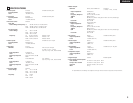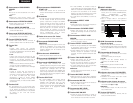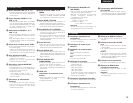
RLLRLR LR RL
L
R
R
L
R
L
RL
RL
L R LR
DP-DJ151
Digital
Quartz
A
N
T
I
-
S
K
A
T
I
N
G
7
6
5
4
3
2
1
0
ON
SLOW
BRAKE
OFF
POWER
START
/STOP
45
0
1
2
3
4
33
78
+12
0
-12
PITCHKEY ADJUST
DP-DJ151
Digital
Quartz
A
N
T
I
-
S
K
A
T
I
N
G
7
6
5
4
3
2
1
0
ON
SLOW
BRAKE
OFF
POWER
START
/STOP
45
0
1
2
3
4
33
78
+12
0
-12
PITCHKEY ADJUST
DP-DJ151
Digital
Quartz
A
N
T
I
-
S
K
A
T
I
N
G
7
6
5
4
3
2
1
0
ON
SLOW
BRAKE
OFF
POWER
START
/STOP
45
0
1
2
3
4
33
78
+12
0
-12
PITCHKEY ADJUST
8
ENGLISH
4
CONNECTIONS
Refer to the connection diagram below.
1. Make certain AC power is off while making
connections.
2. Quality cables make a big difference in fidelity and
punch. Use high-quality, audio cables.
3. Do not use excessively long cables. Be sure plugs
and jacks are securely fastened. Loose connections
cause hum, noise, or intermittents that could
damage your speakers.
4. Connect all stereo input sources. Then connect any
effects into the stereo effect, if used. Connect your
microphone(s) and monitor headphones. Make sure
all faders are at “zero” and the unit is off. Take care
to connect only one cable at a time. pay attention to
L and R position of jacks, on both the DN-X1500 and
outboard gear.
5. Connect the stereo outputs to the power
amplifier(s) and/or tape deck(s) and/or MD
recorder(s) and/or CD recorder(s). Plug the DN-
X1500 into AC power outlet.
Tape deck
Turntable 2
Main unbalanced power amplifier
Main balanced power amplifier
Booth unbalanced power amplifier
MD recorderCD recorder or PC
CD player
1/4” TRS
mono jack
NOTE:
Always switch on your audio input sources such as
CD players first, then your mixer, and finally any
amplifiers. When turning off, always reverse this
operation by turning off amplifiers, then your mixer,
and then input units.
CD player
Turntable 1Turntable 3
3.5 mm stereo mini cord
3.5 mm stereo mini cord
1/4” TS mono jack
Effects processor
1/4” TS mono jack
1/4” TS mono jack
1/4” TS mono jack
XLR or 1/4” TRS
mono jack
Balanced microphones


















